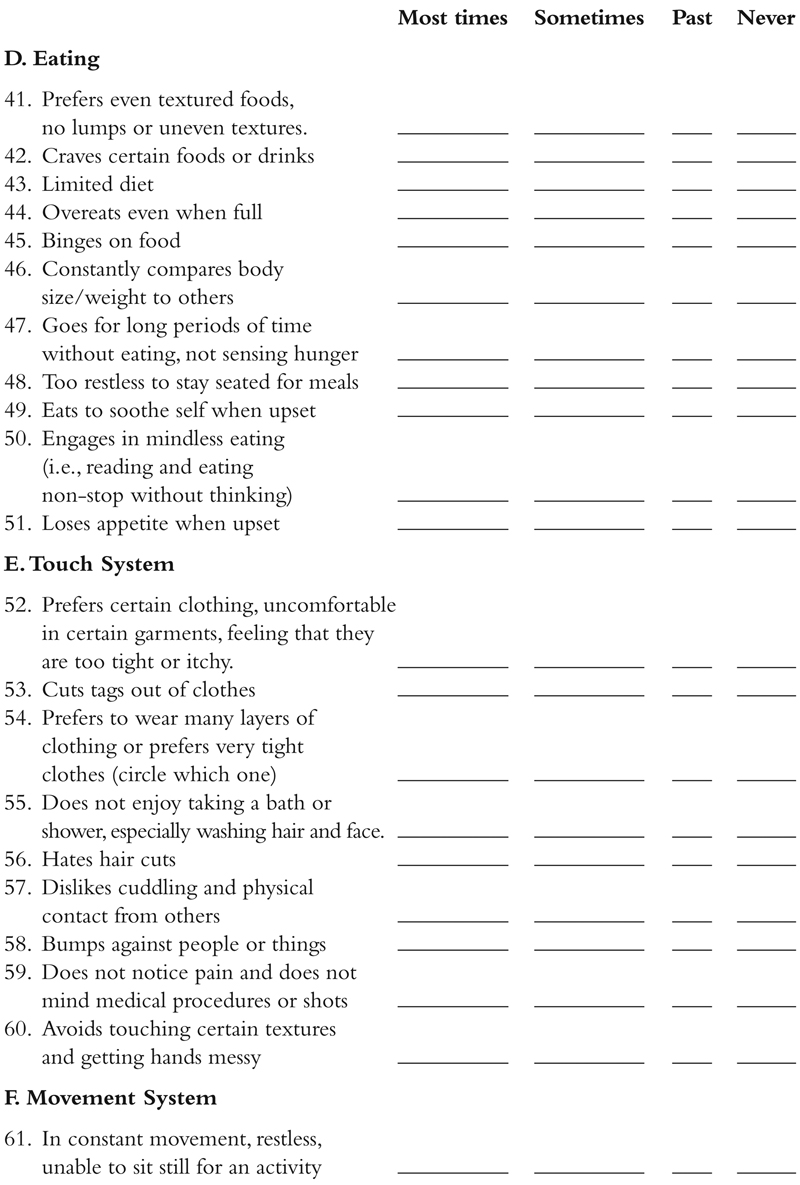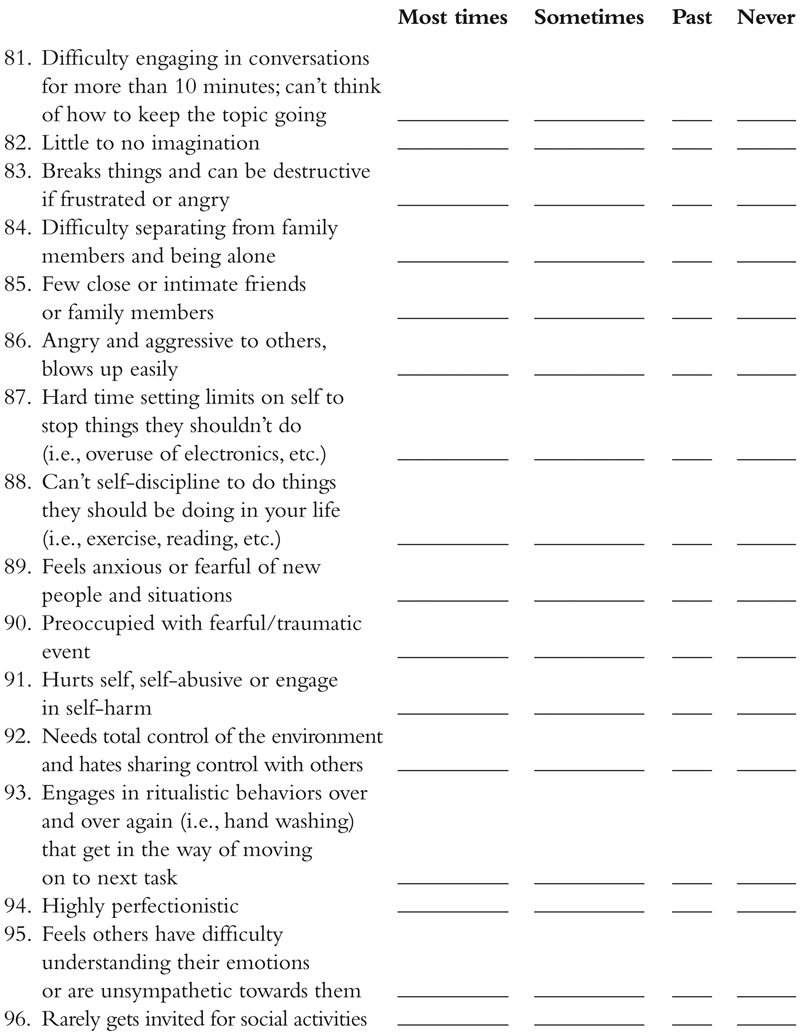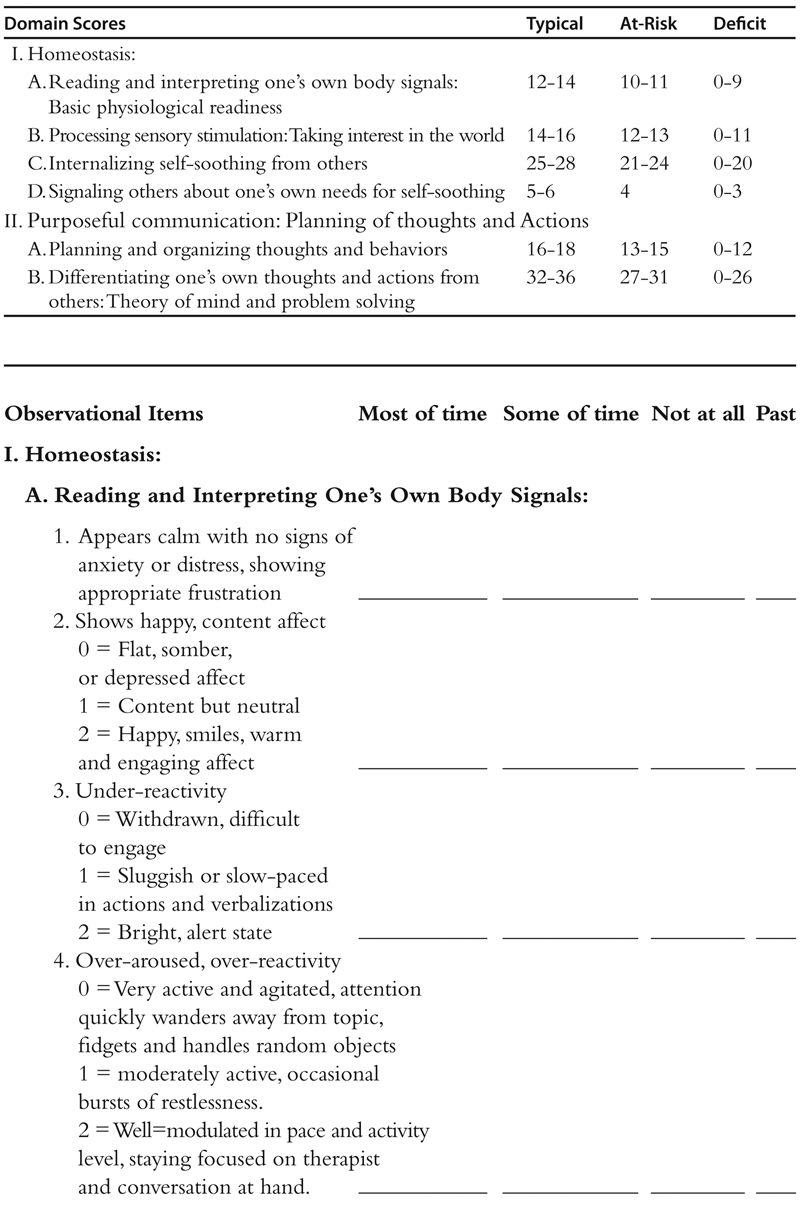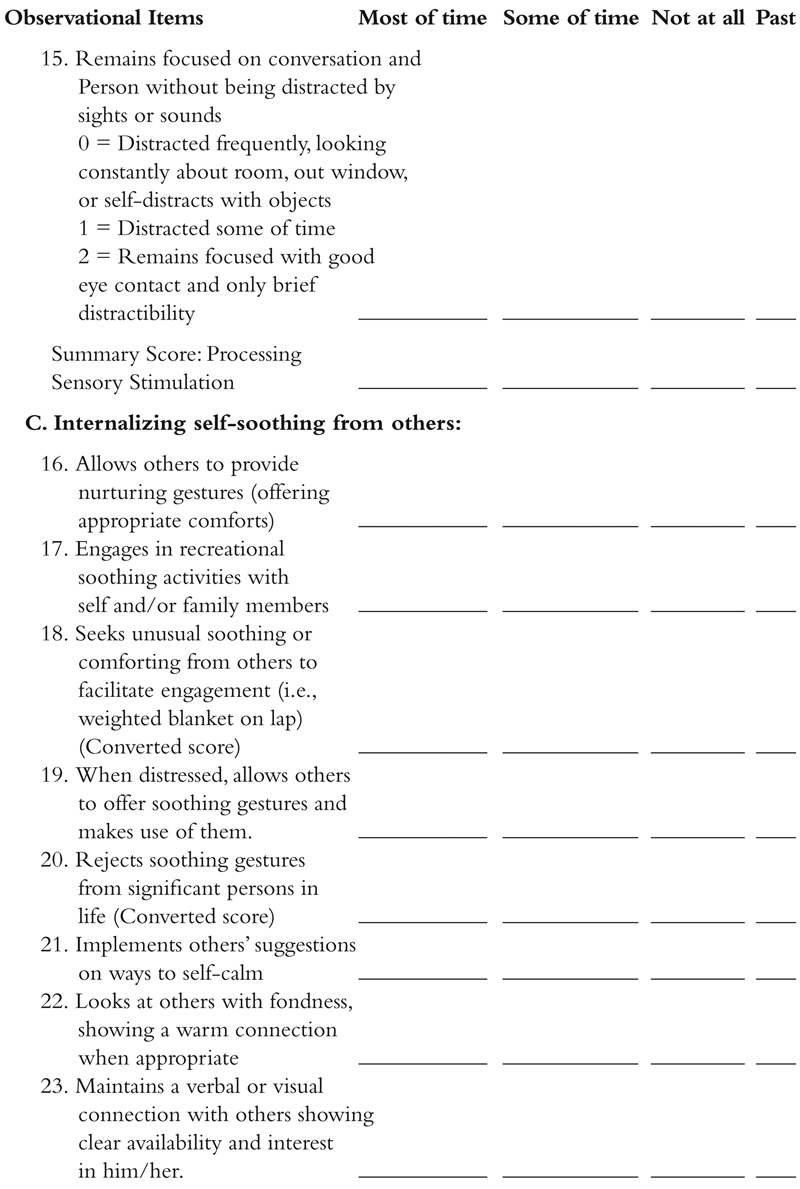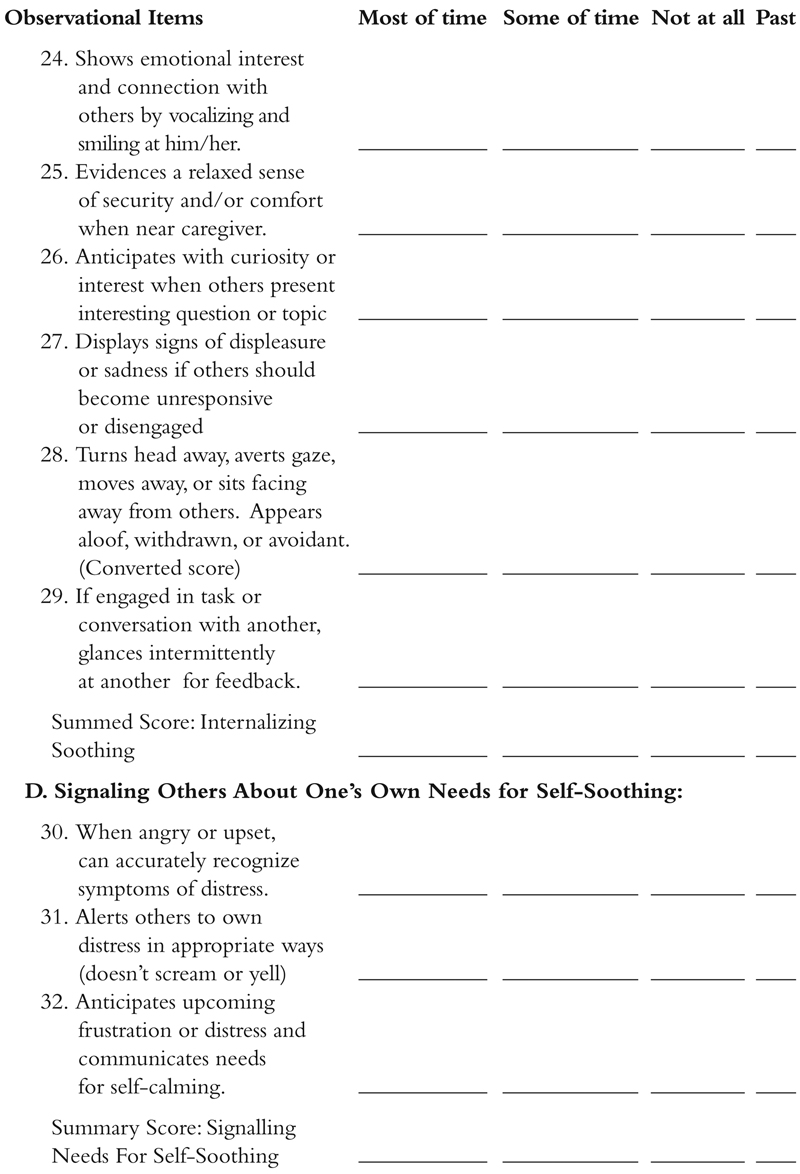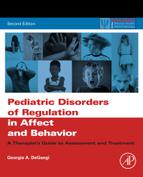References
Als H. Patterns of infant behavior: analogs of later organizational difficulties?. In: Duffy FH, Geschwind N, eds. Dyslexia: a neuroscientific approach to clinical evaluation. Boston: Little, Brown, & Co; 1982:67–92.
Als H, Lester BM, Tronick EZ, Brazelton TB. Towards a research instrument for the Assessment of Preterm Infants’ Behavior (APIB). In: Fitzgerald H, Lester BM, Yogman MW, eds. Theory and research in behavioral pediatrics. New York: Plenum Press; 1982:35–132.
Anders TF. Infant sleep, nighttime relationships, and attachment. Psychiatry. 1994;57:11–21.
Bates JE. Infant characteristics questionnaire, revised. Bloomington: Indiana University; 1984.
Baumeister RF. Escaping the self: alcoholism, spirituality, masochism, and other flights from the burden of selfhood. New York: Basic Books; 1991.
Baumeister RF. Meanings of life. New York: Guildford; 1991.
Baumeister RF, Heatherton TF, Tice DM. Losing control: how and why people fail at self-regulation. New York: Academic Press; 1994.
Brazelton T, Koslowski B, Main M. The origins of reciprocity: the early mother-infant interaction. In: Lewis M, Rosenblum L, eds. The effect of the infant on its caregiver. New York: Wiley & Sons; 1974.
Chess S, Thomas A, Hassibi M. Depression in childhood and adolescence: a prospective study of six cases. Journal of Nervous and Mental Disease. 1983;171:411–420.
DeGangi GA, Breinbauer C. The symptomatology of infants and toddlers with regulatory disorders. Journal of Developmental and Learning Disorders. 1997;1(1):183–215.
DeGangi GA, Greenspan SI. The development of sensory functioning in infants. Physical & Occupational Therapy in Pediatrics. 1988;8(3):21–33.
DeGangi GA, Porges SW, Sickel R, Greenspan SI. Four-year follow-up of a sample of regulatory disordered infants. Infant Mental Health Journal. 1993;14(4):330–343.
DeGangi GA, Poisson S, Sickel RZ, Wiener AS. The infant-toddler symptom checklist. Tucson, AZ: Therapy Skill Builders; 1995.
DeGangi GA, Sickel RZ, Wiener AS, Kaplan EP. Fussy babies: to treat or not to treat?. British Journal of Occupational Therapy. 1996;59(10):457–464.
DeGangi GA, Sickel RZ, Kaplan EP, Wiener AS. Mother-infant interactions in infants with disorders of self-regulation. Physical & Occupaional Therapy in Pediatrics. 1997;17(1):17–44.
DeGangi GA, Breinbauer C, Roosevelt J, Porges S, Greenspan S. Prediction of childhood problems at 36 months in children experiencing disorders of regulation during infancy. Infant Mental Health Journal. 2000;21(3):156–175.
Field T. Gaze behavior of normal and high-risk infants and during early interactions. Infant Mental Health Journal. 1981;20:308–317.
Fish B, Dixon WJ. Vestibular hyporeactivity in infants at risk for schizophrenia. Archives of General Psychiatry. 1978;35:963–971.
Fisher AG, Murray CA, Bundy AC. Sensory integration: Theory and practice. Philadelphia, PA: F.A. Davis Company; 1991: .
Fonagy P, Gergely G, Jurist E, Target M. Affect regulation, mentalization, and the development of the self. New York: Other press; 2004.
Forsyth BW, Canny PF. Perceptions of vulnerability 3-1/2 years after problems of feeding and crying behavior in early infancy. Pediatrics. 1991;88:757–763.
Greenspan SI. The development of the ego: implications for personality theory, psychopathology, and the psychotherapeutic process. Madison, CT: International Universities Press; 1989.
Greenspan SI. Infancy and early childhood: the practice of clinical assessment and intervention with emotional and developmental challenges. Madison, CT: International Universities Press; 1992.
Greenspan SI, DeGangi G, Wieder S. The functional emotional assessment scale (FEAS) for infancy & early childhood. Bethesda, MD: Interdisciplinary Council on Developmental and Learning Disorders; 2001.
Himmelfarb S, Hock E, Wenar C. Infant temperament and noncompliant behavior at four years: a longitudinal study. Genetic, Social, and General Psychology Monographs. 1985;111:7–21.
Kashani JH, Ezpeleta L, Dandoy AC, Doi S, Reid JC. Psychiatric disorders in children and adolescents: the contribution of the child’s temperament and the parents’ psychopathology and attitudes. Canadian Journal of Psychiatry. 1991;36(8):569–573.
Kopp CB. The growth of self-regulation: parents and children. In: Eisenberg N, ed. Perspectives in developmental psychology. New York: Wiley; 1987:34–55.
Kopp CB. Regulation of distress and negative emotions: a developmental view. Developmental Psychology. 1989;25:343–354.
Kopp CB. Emotion-focused coping in young children: self and self-regulatory processes. New Directions in Child and Adolescent Development. 2009;124:33–46: .
Kopp CB. Development in the early years: socialization, motor development, and consciousness. Annual Review of Psychology. 2011;62:165–187.
Kopp CB, Krakow JB, Vaughn B. Patterns of self-control in young handicapped children. Minnesota Symposium on Child Development. 1983;16:93–128.
Lachmann FM, Beebe B. The contribution of self- and mutual regulation to therapeutic action: a case illustration. In: Moskowitz M, Monk C, Kaye C, Ellman S, eds. The Neurobiological and Developmental Basis for Psychotherapeutic Intervention. Northvale, N.J.: Jason Aronson, Inc; 1997:91–121.
Lyons-Ruth K, Zeanah CH. The family context of infant mental health: I. Affective development in the primary caregiving relationship. In: Zeanah CH, ed. Handbook of Infant Mental Health. New York: Guilford Press; 1993:14–37.
Mattison RE, Handford HA, Vela-Bueno A. Sleep disorders in children. Psychiatric Medicine. 1987;4:149–164.
Mikulincer M. Cognitive interference and learned helplessness: the effects of off-task cognitions on performance following unsolvable problems. Journal of Personality and Social Psychology. 1989;57:129–135.
Oberklaid F, Sanson A, Pedlow R, Prior M. Predicting preschool behavior problems from temperament and other variables in infancy. Pediatrics. 1993;91(1):113–120.
Porges S. Social engagement and attachment: a phylogenetic perspective. Annual New York Academy of Science. 2003;1008:31–47: .
Porges S. Reciprocal influences between body and brain in the perception and expression of affect: a polyvagal perspective. In: Fosha D, Siegel DJ, Solomon MF, eds. The healing power of emotion: affective neuroscience, development, clinical practice. New York: Norton; 2009.
Rai S, Malik SC, Sharma D. Behavior problems among preschool children. Indian Pediatrics. 1993;30(4):475–478.
Rizzolatti G, Arbib MA. Language within our grasp. Trends in Neuroscience. 1998;21:188–194.
Rizzolatti G, Fabbri-Destro M. The mirror system and its role in social cognition. Current Opinions in Neurobiology. 2008;18(2):179–184.
Rizzolatti G, Fabbri-Destro M, Cattaneo L. Mirror neurons and their clinical relevance. National Clinical Practice of Neurology. 2009;5(1):24–34.
Rothbart MK, Derryberry D, Development of individual differences in temperament. Lamb ME, Brown AL, eds. Advances in developmental psychology, Vol. 1. Hillsdale, NJ: Erlbaum; 1981:1981.
Rutter M. Individual differences. In: Rutter M, Hersov L, eds. Child psychiatry: modern approaches. Oxford: Blackwell Scientific Publications; 1977:3–21.
Siegel DJ. The developing mind: how relationships and the brain interact to shape who we are. New York: Guilford Press; 1999.
Solms M, Turnbull O. The brain and the inner world. New York: Other Press; 2002.
Sroufe LA. Socioemotional development. In: Osofsky J, ed. Handbook of infant development. New York: Wiley & Sons; 1979.
Sroufe LA. Attachment and development: a prospective, longitudinal study from birth to adulthood. Attachment in Human Development. 2005;7(4):349–367: .
Sroufe LA, Fox NE, Pancake VR. Attachment and dependency in developmental perspective. Child Development. 1983;54:1615–1627.
Sroufe LA, Coffino B, Carlson EA. Conceptualizing the role of early experience: lessons from the minnesota longitudinal study. Developmental review. 2010;30(1):36–51.
Teerikangas OM, Aronen ET, Martin RP, Huttunen MO. Effects of infant temperament and early intervention on the psychiatric symptoms of adolescents. Journal of American Academy of Child and Adolescent Psychiatry. 1998;37(10):1070–1076.
Thelen E, Self-organization in developmental processes: can systems approaches work?. Gunnar M, ed. Systems in development: the Minnesota symposium in child psychology, Vol. 22. Hillsdale, N.J.: Erlbaum; 1989:77–117.
Tronick EZ. Emotions and emotional communication in infants. American Psychologist. 1989;44(2):112–119.
Tronick E, Beeghly M. Infants’ meaning-making and the development of mental health problems. American Psychology. 2011;66(2):107–119.
Tschann JM, Kaiser P, Chesney MA, Aldon A, Boyce WT. Resilience and vulnerability among preschool children: family functioning, temperament, and behavior problems. Journal of American Academy of Child and Adolescent Psychiatry. 1996;35(2):184–192.
Walker E, Emory E. Infants at risk for psychopathology: offspring of schizophrenic parents. Child Development. 1983;54:1269–1285.
Weissbluth M. Sleep-loss stress and temperamental difficultness: psychobiological processes and practical considerations. In: Kohnstamm GA, Bates JE, Rothbart MK, eds. Temperament in Childhood. New York: Wiley & Sons; 1969.
Zero to Three. Diagnostic classification of mental health and developmental disorders of infancy and early childhood. Arlington, VA: National Center for Clinical Infant Programs; 1994.
Zimmermann BJ. Attaining self-regulation: a social cognitive perspective. In: Boekaerts M, Pintrich PR, Zeidner M, eds. Handbook of self-regulation. New York: Academic Press; 2005:13–41: .





